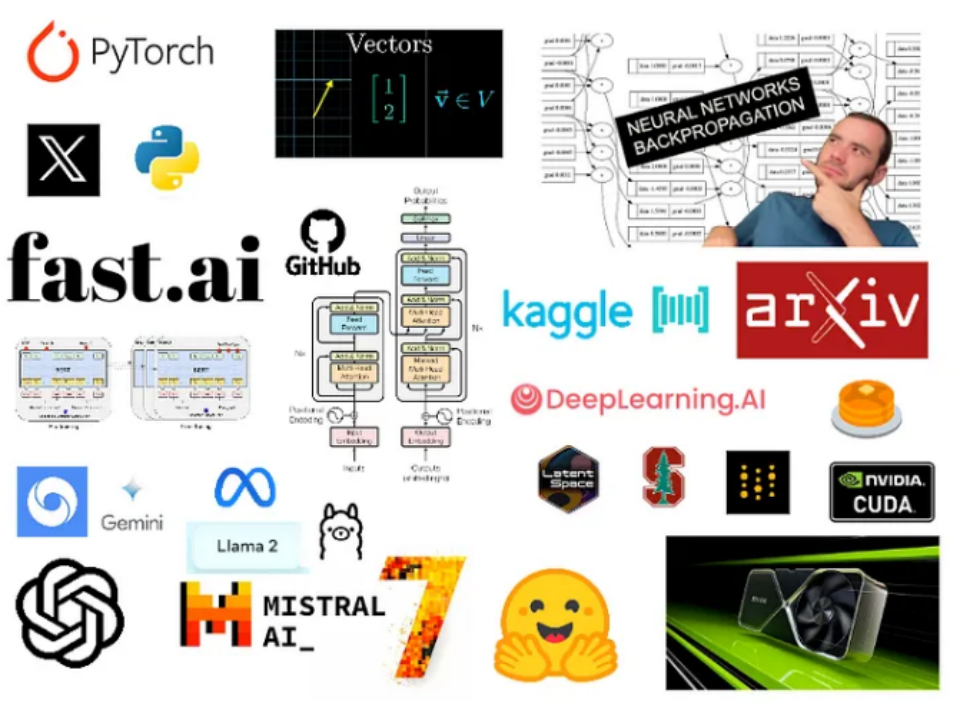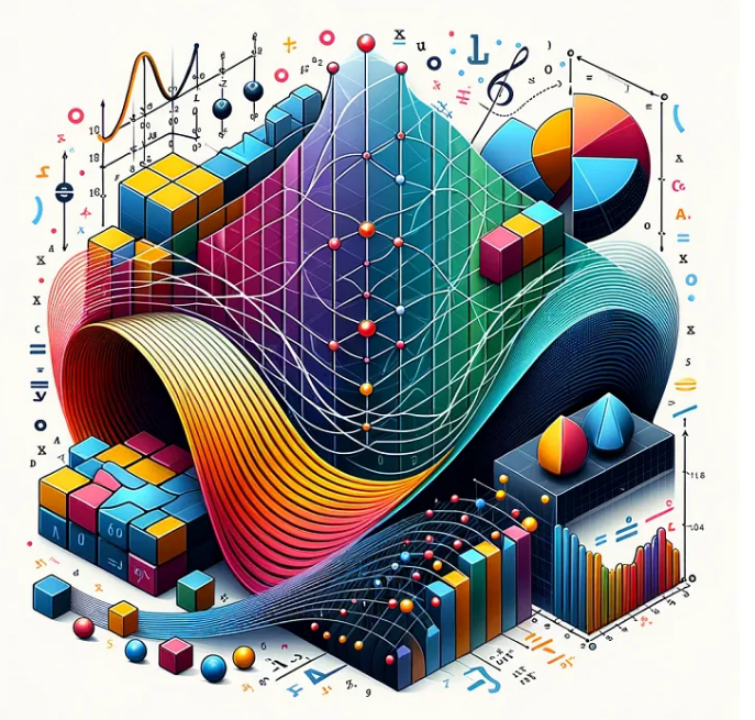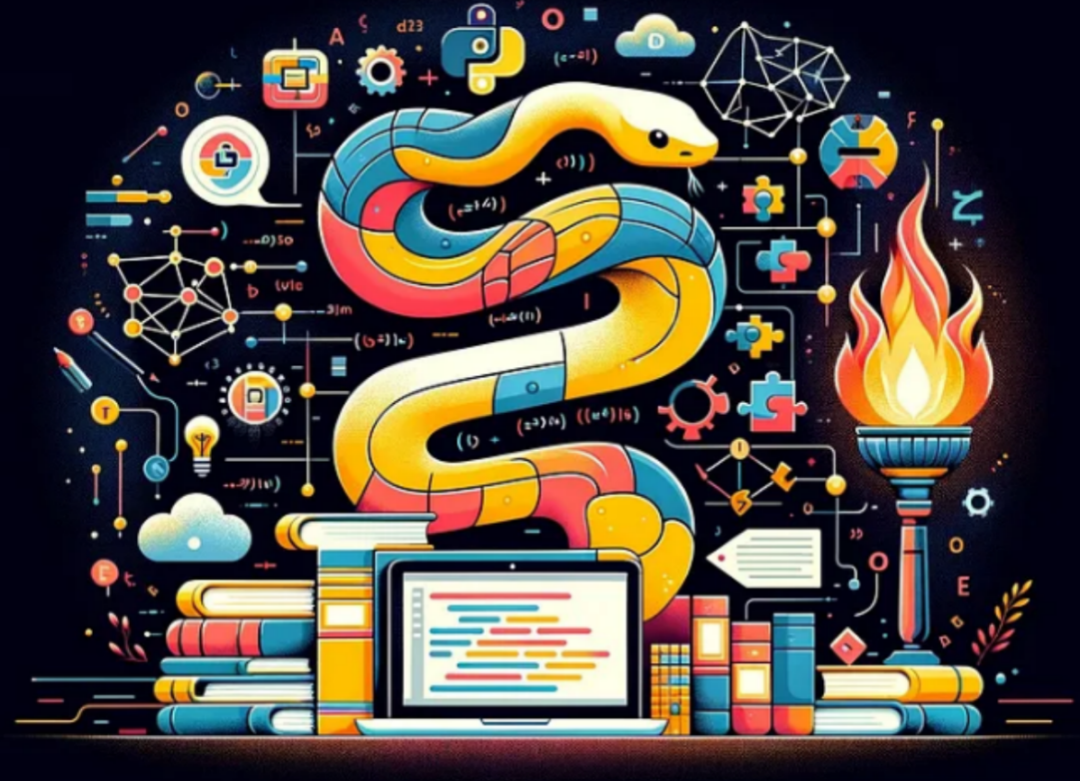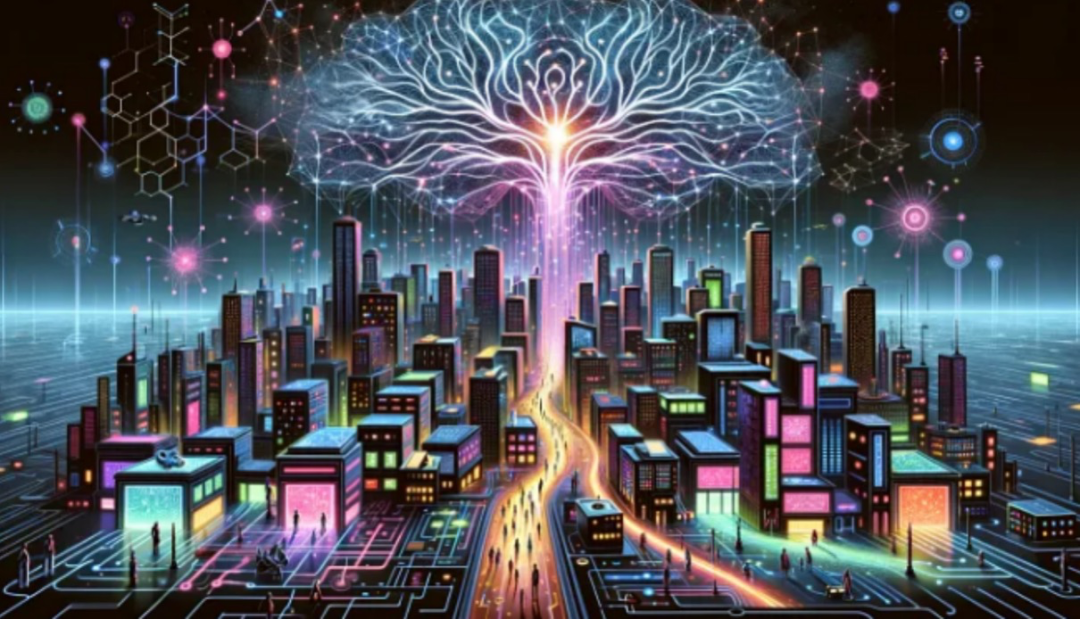
Author: Benedict Neo February 9, 2024
Translator: Chen Zhiyan, Pan Lanyu
Proofreader: Pan Lanyu
This article is about 8000 words long and is recommended to read in 15 minutes.
This article provides free courses for hackers and programmers to learn artificial intelligence.
If you find this article helpful, please follow me on Twitter and LinkedIn! I share interesting links with friends every week and you can subscribe in time.Want to learn AI but don’t know how or where to start?Back in 2020, I wrote down the top 20 free data science, ML, and AI MOOCs on the internet (https://towardsdatascience.com/top-20-free-data-science-ml-and-ai-moocs-on-the-internet-4036bd0aac12), and many of the courses have changed significantly since then.To escape the “tutorial trap” and learn real skills, you must practice hands-on, write algorithms from scratch, reproduce papers, and solve real-world problems with AI through real projects.This article designs a set of free courses that follow this philosophy, and I am also learning some of these courses myself, so if you want to learn together, please contact me on Twitter or LinkedIn!Additionally, if you think the course content is incomplete, please leave a comment!First, some notes about the course and some learning suggestions.

Using Excalidraw for drawing
Top-Down Approach
This course follows a top-down approach — code first, then theory.I tend to learn based on practical needs. So, if I need to figure something out, solve a problem, or prototype, I will gather the necessary information widely, study it in depth, understand it, and then take action.For example, my goal is to become an AI engineer who understands LLMs (https://www.latent.space/p/ai-engineer), which requires skills like writing Transformers from scratch and fine-tuning LLMs on GPUs. However, due to knowledge gaps, I am currently unable to do these. Therefore, my goal is to fill these gaps.This course mainly focuses on Natural Language Processing (NLP). If you seek to learn other AI specialties, such as computer vision or reinforcement learning, please comment at the end of the article or DM me on Twitter or LinkedIn, and I will give you some suggestions.Before handing you a bunch of links, I hope someone can tell me two important things before starting to learn.
Learn in Public
There is so much to learn, perhaps never-ending. Especially in AI, new revolutionary papers and ideas are released weekly.The biggest mistake one can easily make is to learn in private. This creates no opportunities for oneself. Aside from being able to say you completed something, there’s nothing to showcase. More importantly, how to utilize that information, transform it into knowledge, and share it with the public, along with new ideas and solutions, is crucial.So, you should learn in public (https://www.swyx.io/learn-in-public). This means developing a habit of creating, such as:
- Writing blogs and tutorials
- Joining hackathons and collaborating with others
- Asking and answering questions in Discord communities
- Working on personal projects that interest you
- Posting interesting things you find on Twitter
Now let’s talk about Twitter.
Using Twitter
If you follow the right people and use it correctly, Twitter is the most valuable social platform anyone can participate in today.Who to follow? Check out Suhail’s AI list (https://twitter.com/i/lists/1539497752140206080?s=20).How to use Twitter? Please read Neil’s “How to Twitter Successfully” (https://near.blog/how-to-twitter-successfully/?curius=1935).When sending DMs to others on Twitter, be sincere, concise, and make specific requests. Sriram Krishnan’s guide “How to Write Cold Emails” (https://sriramk.com/coldemail/) also applies to DMs.How to tweet? Please read Instructor founder Jason’s “Tweet Anatomy” (https://mp.weixin.qq.com/cgi-bin/appmsg?t=media/appmsg_edit_v2&action=edit&isNew=1&type=77&createType=0&token=837735478&lang=zh_CN×tamp=1712153003025#hook). He grew from 0 followers to 14k in a few months.If you are reading this article, please follow me on Twitter! DM me and let me know what you’re working on! I would love to collaborate on some cool projects with you.Now let’s get started.
Content List
- 1 Mathematics
- 2 Tools∘2.1 Python (https://mp.weixin.qq.com/cgi-bin/appmsg?t=media/appmsg_edit_v2&action=edit&isNew=1&type=77&createType=0&token=837735478&lang=zh_CN×tamp=1712153003025#6e37)∘2.2 PyTorch
- 3 Machine Learning∘ 3.1 Hands-on Practice from Scratch∘3.2 Competitions∘3.3 Project Implementation∘3.4 Project Deployment∘3.5 Supplement
- 4 Deep Learning∘4.1 Fast.ai∘ 4.2 Participate in More Competitions∘ 4.3 Paper Reproduction∵4.4 Computer Vision∘4.5 Reinforcement Learning∘ 4.6 NLP
- 5 Large Language Models
∘ 5.1 Watch Neural Networks: From Zero to Hero
∘ 5.2 Free LLM Bootcamp
∘ 5.3 Build Applications with LLMs
∘ 5.4 Participate in Hackathon Competitions
∘ 5.5 Read Papers
∘ 5.6 Write Transformers from Scratch (https://mp.weixin.qq.com/cgi-bin/appmsg?t=media/appmsg_edit_v2&action=edit&isNew=1&type=77&createType=0&token=837735478&lang=zh_CN×tamp=1712153003025#4df0)
∘ 5.7 Some Quality Blogs
∘ 5.8 Watch Umar Jamil’s Videos
∘ 5.9 Learn How to Run Open Source Models
∘ 5.10 Prompt Engineering
∘ 5.11 Fine-tune LLMs
∘ 5.12 RAG
- 6 How to Keep Up with Cutting-Edge Trends
- 7 Other Useful Resources
1 Mathematics

DALL·EMachine learning relies on three major pillars of mathematics: linear algebra, calculus, and probability and statistics. Each plays a unique role in enabling algorithms to operate effectively.
- Linear Algebra: A mathematical toolbox for data representation and manipulation, where matrices and vectors form the language for algorithms to interpret and process information;
- Calculus: The optimization engine of machine learning, learning and improving algorithms through understanding gradients and rates of change;
- Probability and Statistics: The foundation for decision-making under uncertainty, modeling randomness and variability to enable algorithms to predict outcomes from data.
From a programmer’s perspective, here’s an excellent video series on the mathematics of machine learning: “Mathematics for Machine Learning” by the Weight & Biases team (https://www.youtube.com/playlist?list=PLD80i8An1OEGZ2tYimemzwC3xqkU0jKUg) (code) (https://github.com/wandb/edu/tree/main/math-for-ml).
If you want to learn linear algebra methods starting from code, check out the “Computational Linear Algebra” created by the fast.ai team (https://www.fast.ai/posts/2017-07-17-num-lin-alg.html) (video, code) (https://www.youtube.com/playlist?list=PLtmWHNX-gukIc92m1K0P6bIOnZb-mg0hY). During your learning process, you can read “An Introduction to Linear Algebra with Python for Applied Machine Learning” (https://pabloinsente.github.io/intro-linear-algebra).
If you want to learn something more traditional, you can watch the lectures from Imperial College London on “Linear Algebra” (https://www.youtube.com/playlist?list=PLiiljHvN6z1_o1ztXTKWPrShrMrBLo5P3) and “Multivariable Calculus” ( https://www.youtube.com/playlist?list=PLiiljHvN6z193BBzS0Ln8NnqQmzimTW23).
You can also watch 3Blue1Brown’s “The Essence of Linear Algebra” and “The Essence of Calculus.”“The Essence of Linear Algebra” (https://www.youtube.com/playlist?list=PLZHQObOWTQDPD3MizzM2xVFitgF8hE_ab) “The Essence of Calculus” (https://www.youtube.com/playlist?list=PLZHQObOWTQDMsr9K-rj53DwVRMYO3t5Yr).If you want to learn statistics, you can watch StatQuest’s “Statistics Fundamentals” (https://www.youtube.com/playlist?list=PLblh5JKOoLUK0FLuzwntyYI10UQFUhsY9).SupplementBooks:“Mathematics for Machine Learning” (https://mml-book.github.io/book/mml-book.pdf).Papers: “Matrix Calculus for Deep Learning” (https://arxiv.org/pdf/1802.01528.pdf).
2 Tools

DALL·E
2.1 Python
For beginners: “Practical Python Programming” https://dabeaz-course.github.io/practical-python/Notes/Contents.htmlFor those with some Python background: “Advanced Python Mastery” https://github.com/dabeaz-course/python-mastery?tab=readme-ov-fileBoth courses are produced by David Beazley, the author of the Python Cookbook, and are well made.After that, you can watch some talks by James Powell and read the book “Python Design Patterns.”
Some Talks by James Powell
https://www.youtube.com/playlist?list=PLdQruVCKu10lhVEnAQqRncVc8EIQN-x-X
“Python Design Patterns”
https://python-patterns.guide/
Supplement
Book: “Fluent Python” Second Edition (code) https://www.oreilly.com/library/view/fluent-python-2nd/9781492056348/Code: https://github.com/fluentpython/example-code-2esPodcasts: “Real Python” and “Talk Python”
“Real Python”
https://realpython.com/podcasts/rpp/
“Talk Python”
https://talkpython.fm/episodes/all
2.2 PyTorch
Watch Aladdin Persson’s “PyTorch Tutorial” Aladdin Perssonhttps://www.youtube.com/c/AladdinPersson“PyTorch Tutorial” https://www.youtube.com/playlist?list=PLhhyoLH6IjfxeoooqP9rhU3HJIAVAJ3VzThe PyTorch official website also provides a wealth of learning resources:
- PyTorch Examples Tutorial (https://pytorch.org/examples/)
- PyTorch Official Tutorials (https://pytorch.org/tutorials/index.html)
- FAQ (https://pytorch.org/docs/stable/notes/faq.html)
Complete some interesting puzzles to test your PyTorch knowledge:lsrush/Tensor-Puzzles: Improve your PyTorch skills by solving puzzles (https://github.com/srush/Tensor-Puzzles).
Supplement
Book: “Programming Deep Learning with PyTorch” (https://www.oreilly.com/library/view/programming-pytorch-for/9781492045342/).3 Machine Learning

DALL·EContinue reading “The Hundred-Page Machine Learning Book.”
https://themlbook.com/
3.1 Hands-on Practice from Scratch
While reading theoretical knowledge, try to implement algorithms from scratch.Refer to the following code repositories:
- leriklindernoren/ML-From-Scratch (https://github.com/eriklindernoren/ML-From-Scratch)
- lJeremyNixon/oracle (https://github.com/JeremyNixon/oracle)
- ltrekhleb/homemade-machine-learning (https://github.com/trekhleb/homemade-machine-learning)
If you want a challenge, try to build a PyTorch deep learning framework from scratch with the following course:lMiniTorch: Machine Learning Engineering DIY Course (video, code) MiniTorch: Machine Learning Engineering DIY Course https://minitorch.github.io/Videohttps://www.youtube.com/playlist?list=PLO45-80-XKkQyROXXpn4PfjF1J2tH46w8Codehttps://github.com/minitorch
3.2 Competitions
Apply what you have learned in competitions.Participate in ML competitions on platforms like bitgrit and Kaggle; you can read this article for more information.bitgrit https://bitgrit.net/competition/Kaggle https://www.kaggle.com/This article https://towardsdatascience.com/12-data-science-ai-competitions-to-advance-your-skills-in-2021-32e3fcb95d8c
Study past winning solutions: learn and analyze how they solved problems.
https://farid.one/kaggle-solutions
3.3 Project Implementation
Read Vicki Boykis’ “Getting Machine Learning to Production.”https://vickiboykis.com/2020/06/09/getting-machine-learning-to-production/Vicki Boykis also wrote an article about constructing a semantic search engine for books called Viberary, which can serve as a reference.https://vickiboykis.com/2024/01/05/retro-on-viberary/Obtain a dataset and build a model (i.e., use earthaccess to get NASA’s geographic data).https://www.earthdata.nasa.gov/learn/blog/earthaccessCreate a UI with streamlit and share it on Twitter.https://streamlit.io/
3.4 Project Deployment
Deploy the model to production and track experimental results, learn how to monitor models, and experience data and model drift firsthand.Here are some quality resources:
-
Made With ML (https://madewithml.com/)
-
DataTalksClub/mlops-zoomcamp: Free MLOps Tutorial (https://github.com/DataTalksClub/mlops-zoomcamp)
-
chiphuyen/Machine Learning Systems Design (https://github.com/chiphuyen/machine-learning-systems-design)
-
Evidently AI — Machine Learning Systems Design 300 Examples (https://www.evidentlyai.com/ml-system-design)
-
stas00/ml Engineering: Online Book on Machine Learning Engineering (https://github.com/stas00/ml-engineering)
3.5 Supplement
PyTorch and Scikit-Learn Machine Learning (code) PyTorch and Scikit-Learn Machine Learning https://www.oreilly.com/library/view/machine-learning-with/9781801819312/Code https://github.com/rasbt/machine-learning-book[1811.12808] Machine Learning Model Evaluation, Model Selection, and Algorithm Selection https://arxiv.org/abs/1811.12808Machine Learning Interview Guide · MLIB https://huyenchip.com/ml-interviews-book/
4 Deep Learning

If you want to learn from the top down, start with fast.ai.
4.1 Fast.ai
lfast.ai (part1, part2) + W&B Study Group
part1
https://course.fast.ai/
part2
https://course.fast.ai/Lessons/part2.html
W&B Study Group https://wandb.ai/wandb_fc/events/reports/W-B-Study-Group-Lectures-fast-ai-w-Hugging-Face–Vmlldzo4NDUzNDU?galleryTag=eventsIf you like fast.ai, check out the “Full Stack Deep Learning” course.https://fullstackdeeplearning.com/course/2022If you want a more comprehensive classic course, consider François Fleuret’s “UNIGE 14×050 – Deep Learning” course.
François Fleuret
https://fleuret.org/francois/
“UNIGE 14×050 – Deep Learning”
https://fleuret.org/dlc/If you need theoretical resources during your learning process, here are some great books:“Deep Learning” (with PyTorch, NumPy/MXNet, JAX, and TensorFlow example source codes) https://d2l.ai/index.htmlIan Goodfellow, Yoshua Bengio, and Aaron Courville’s “Deep Learning” https://www.deeplearningbook.org/“Neural Networks and Deep Learning” http://neuralnetworksanddeeplearning.com/“Understanding Deep Learning” (with notes) https://udlbook.github.io/udlbook/https://github.com/udlbook/udlbook/tree/main/NotebooksInstead of scrolling social media, read “Deep Learning Book” on your phone.https://fleuret.org/francois/lbdl.htmlDuring the gaps in training neural networks, check out these resources:“Secrets to Training Neural Networks” https://karpathy.github.io/2019/04/25/recipe“Deep Neural Networks: 33 Years Ago and 33 Years After” https://karpathy.github.io/2022/03/14/lecun1989/
4.2 Participate in More Competitions
PlantTraits2024 — FGVC11 | Kaggle (Computer Vision) https://www.kaggle.com/competitions/planttraits2024
4.3 Paper Reproduction
Check out labml.ai’s annotated PyTorch paper reproduction. https://nn.labml.ai/index.htmlPapers with Code is a great resource website for papers, such as this article explaining BERT on their site. https://paperswithcode.com/method/bertHere are some professional resources for deep learning.
4.4 Computer Vision
Many recommend “CS231n: Deep Learning for Computer Vision.” This course is challenging but worth a try. http://cs231n.stanford.edu/
4.5 Reinforcement Learning
For the field of reinforcement learning, the following two resources are excellent:OpenAI’s “Spinning Up in Deep Reinforcement Learning” https://spinningup.openai.com/en/latest/Hugging Face’s “Deep Reinforcement Learning Course” https://huggingface.co/learn/deep-rl-course/unit0/introduction
4.6 NLP
Another excellent course from Stanford: “CS 224N | Deep Learning for Natural Language Processing” https://web.stanford.edu/class/archive/cs/cs224n/cs224n.1234/Learn “Hugging Face: Hugging Face NLP Course” https://huggingface.co/learn/nlp-course/chapter1/1Check out the Super Duper NLP Repo https://notebooks.quantumstat.com/?trk=public_post-textQuality Articles and Analyses“BERT Research – Episode 1 – Core Concepts and Resources” – Chris McCormick https://mccormickml.com/2019/11/11/bert-research-ep-1-key-concepts-and-sources“Illustrated Word2vec” – Jay Alammar https://jalammar.github.io/illustrated-word2vec“Illustrated BERT, ELMo, and Other NLP Models (How NLP Cracks Transfer Learning)” https://jalammar.github.io/illustrated-bert“Understanding LSTM Networks” — Colah’s Blog https://colah.github.io/posts/2015-08-Understanding-LSTMs“Implementing RNN from Scratch with PyTorch” – Jake Tae https://jaketae.github.io/study/pytorch-rnn/Supplement“Transformers for Natural Language Processing” Book https://transformersbook.com/
5 Large Language Models

First, watch Andrej’s “Introduction to Large Language Models in One Hour.”https://www.youtube.com/watch?v=zjkBMFhNj_gThen watch Alexander Rush’s “Understanding Large Language Models with Five Formulas” (Cornell Tech Campus) Alexander Rush https://tech.cornell.edu/people/alexander-rush/“Understanding Large Language Models with Five Formulas” https://www.youtube.com/watch?v=KCXDr-UOb9A
5.1 Watch “Neural Networks: From Zero to Hero”
It starts with explaining and writing the backpropagation algorithm and ends with writing GPT from scratch.“Neural Networks: From Zero to Hero,” by Andrej Karpathy https://karpathy.ai/zero-to-hero.htmlHe just released a new video → “Building a GPT Tokenizer” https://www.youtube.com/watch?v=zduSFxRajkEYou can also check out Jay Mody’s “Implementing GPT from Scratch with 60 Lines of NumPy Code” https://jaykmody.com/blog/gpt-from-scratch
5.2 Free LLM Bootcamp
A set of previously paid large language model (LLM) bootcamp courses launched by Full Stack Deep Learning is now available for free.https://fullstackdeeplearning.com/llm-bootcamp/It covers prompt engineering, LLM operations (LLMOps), LLM user experience (UX) design, and how to deploy LLM applications in an hour.By the end of the bootcamp, you must be eager to get started!
5.3 Build Applications with LLMs
Want to build applications with LLMs?Watch Andrew Ng’s “Application Development with LLMs” course. https://nips.cc/virtual/2023/tutorial/73948Read Huyen Chip’s “Building LLM Applications for Production.” https://huyenchip.com/2023/04/11/llm-engineering.htmlRead Eugene Yan’s “Patterns for Building LLM-based Systems and Products.” https://eugeneyan.com/writing/llm-patternsCheck the “OpenAI Cookbook” for code examples. https://cookbook.openai.com/You can quickly get started using the Vercel AI template. https://vercel.com/templates/ai
5.4 Participate in Hackathon Competitions
lablab.ai hosts new AI hackathon competitions weekly. If you are interested in collaboration, please let me know! https://twitter.com/benxneoIf you want to delve deeper into the theory and understand how everything works, please continue reading.
5.5 Read Papers
Sebastian Raschka wrote an excellent article titled “Understanding Large Language Models,” in which he lists some papers worth reading.Sebastian Raschka https://sebastianraschka.com/“Understanding Large Language Models” https://magazine.sebastianraschka.com/p/understanding-large-language-modelsHe recently published another article introducing papers worth reading in January 2024, including papers related to the Mistral model. https://magazine.sebastianraschka.com/p/research-papers-in-january-2024Follow his blog, “The Forward AI,” for more quality paper recommendations. https://magazine.sebastianraschka.com/
5.6 Write Transformers from Scratch
I recommend reading Lilian Weng’s blog post “The Transformer Family Version 2.0 | Lil’Log” for an overview of the architecture of large language models. https://lilianweng.github.io/posts/2023-01-27-the-transformer-family-v2/Choose the format that suits you best and try to implement a Transformer model from scratch.Papers
- Attention Is All You Need (https://arxiv.org/abs/1706.03762)
- The Illustrated Transformer (http://jalammar.github.io/illustrated-transformer/)
- The Annotated Transformer by Harvard (http://nlp.seas.harvard.edu/annotated-transformer/)
- Thinking like Transformer (https://srush.github.io/raspy/)
Blogs“Building Transformers from Scratch: Part 1, Attention Mechanism (Part 2)” (code) https://benjaminwarner.dev/2023/07/01/attention-mechanismCode https://github.com/warner-benjamin/commented-transformersDr. Sebastian Raschka’s “Understanding and Writing the Self-Attention Mechanism of Large Language Models from Scratch” Dr. Sebastian Raschka https://www.linkedin.com/in/ACoAAAxqHaUBEa6zzXN–gv-wd8ih0vevPvr9eU“Understanding and Writing the Self-Attention Mechanism of Large Language Models from Scratch” https://sebastianraschka.com/blog/2023/self-attention-from-scratch.html“Building Transformers from Scratch” https://peterbloem.nl/blog/transformersVideos“Writing Transformer Code from Scratch with PyTorch (with full explanations, training, and inference)” https://www.youtube.com/watch?v=ISNdQcPhsts&t=7449s“NLP: Implementing BERT and Transformers from Scratch” https://www.youtube.com/watch?v=EPa98fyxZ-s&list=PLdM8d_MWyPjV2vKl7Y2jnIIBRu522tiZc&index=9You can now write Transformers from scratch, but there’s still more to learn.Watch Stanford University’s “cs25-Transformer United” course videos. https://www.youtube.com/playlist?list=PLoROMvodv4rNiJRchCzutFw5ItR_Z27CM
5.7 Some Quality Blogs
- “Building Large Language Models from Scratch: A Crazy Gradient Descent Journey” https://bclarkson-code.github.io/posts/llm-from-scratch-scalar-autograd/post.html
- “Illustrated Transformer” (by Jay Alammar) https://jalammar.github.io/illustrated-transformer/
- “Understanding Attention Mechanism and Transformer Models” (by Eugene Yan) https://eugeneyan.com/writing/attention/?curius=1935
- “Accelerating GPT-KV Cache | The Unbeatable Path” https://www.dipkumar.dev/becoming-the-unbeatable/posts/gpt-kvcache/
- “Beyond Self-Attention: How Small Language Models Predict the Next Token” https://shyam.blog/posts/beyond-self-attention/
- “Building Llama from Scratch (or How to Reproduce Papers without Shedding a Tear)” (by Brian Kitano) https://blog.briankitano.com/llama-from-scratch/
- “Improving LoRA: Implementing Weight Decomposition Low-Rank Adaptation (DoRA) from Scratch” https://magazine.sebastianraschka.com/p/lora-and-dora-from-scratch
5.8 Watch Umar Jamil’s Videos
https://www.youtube.com/@umarjamilai/videosHe creates excellent deep explanations of papers and showcases the corresponding code.
- “LoRA: Low-Rank Adaptation for Large Language Models — Visual Explanation + PyTorch Code from Scratch” (https://www.youtube.com/watch?v=PXWYUTMt-AU)
- “Mistral/Mixtral Explained: Sliding Window Attention, Sparse Expert Mixtures, Rolling Buffers” (https://www.youtube.com/watch?v=UiX8K-xBUpE)
- “You Only Need Attention (Transformer) – Model Explanation (including math), Inference and Training” (https://www.youtube.com/watch?v=bCz4OMemCcA)
- “LLaMA Explained: KV Cache, Rotating Positional Embedding, RMS Norm, Group Query Attention, SwiGLU” (https://www.youtube.com/watch?v=Mn_9W1nCFLo)
- “Retrieval-Augmented Generation (RAG) Explained: Embeddings, Sentence BERT, Vector Databases (HNSW)” (https://www.youtube.com/watch?v=rhZgXNdhWDY)
- These links only showcase a portion of the resources related to large language models. Check out the LLM syllabus (https://github.com/mlabonne/llm-course) for a more comprehensive understanding of LLMs.
5.9 Learn How to Run Open Source Models
Refer to “Using Ollama: Run Llama 2, Mistral, and Other Large Language Models Locally” (https://github.com/ollama/ollama).They provide related Python and JavaScript libraries to help you easily run these models.Python and JavaScript Libraries https://ollama.ai/blog/python-javascript-libraries
5.10 Prompt Engineering
Read Lilian Weng’s blog: “Prompt Engineering.” https://lilianweng.github.io/posts/2023-03-15-prompt-engineeringYou can read the developer guide co-authored by OpenAI’s Ise Fulford and Andrew Ng: “ChatGPT Developer Prompt Engineering.” https://www.deeplearning.ai/short-courses/chatgpt-prompt-engineering-for-developers/DeepLearning.ai also offers other free short courses for you to learn. https://www.deeplearning.ai/short-courses/
5.11 Fine-tune LLMs
Read “Hugging Face’s Fine-tuning Guide” https://huggingface.co/docs/transformers/en/trainingA good guide: “Fine-tuning – GenAI Guidebook” https://ravinkumar.com/GenAiGuidebook/language_models/finetuning.htmlLearn about axolotl. https://github.com/OpenAccess-AI-Collective/axolotl?curius=2790This is a great article: “Fine-tune the Mistral-7b Model with Direct Preference Optimization” (by Maxime Labonne) https://towardsdatascience.com/fine-tune-a-mistral-7b-model-with-direct-preference-optimization-708042745aac
5.12 RAG
Anyscale’s excellent article: “Building RAG-based LLM Applications” https://www.anyscale.com/blog/a-comprehensive-guide-for-building-rag-based-llm-applications-part-1?curius=1144Aman Chadha’s overview of Retrieval-Augmented Generation. Aman Chadha https://aman.ai/ Retrieval-Augmented Generation https://aman.ai/primers/ai/RAG/
6 How to Keep Up with Cutting-Edge Trends
Combine news, podcasts, and TwitterFor papers, you can follow AK (@_akhaliq)For podcasts, the best ones are Swyx & Alessio’s Latent SpaceBe sure to join their Discord community.They also have a newsletter called Smol Talk that summarizes all major AI Discord discussions.Some other newsletters I like include:The Batch | DeepLearning.AI | AI News and Insights (https://www.deeplearning.ai/the-batch/)
- Deep Learning Weekly
- Interconnects | Nathan Lambert
- AI Tidbits | Sahar Mor
For more information, see this article https://towardsdatascience.com/20-must-subscribe-data-and-ai-newsletters-in-2021-7c5ddb9b3c19
7 Other Useful Resources
My list is not exhaustive; if you want to find more materials, here are some recommendations:
- openai/syllabus.md
- AI Canon | Andreessen Horowitz
- AI Learning Curation — LLM Utils
- Threshold to the AI Multiverse | Open DeepLearning
- louisfb01/start-llms: A Complete Guide to Starting and Improving LLM Skills in 2023
I spent a lot of time writing and organizing this content; it’s time to start learning and building models.I hope this article will assist you on your AI journey!Editor: Wang Jing
Translator Introduction

Chen Zhiyan, graduated from Beijing Jiaotong University with a Master’s degree in Communication and Control Engineering. Previously worked as an engineer at Great Wall Computer Software and Systems Co., Ltd. and Datang Microelectronics Co., Ltd., currently working at Beijing Wuyichaoqun Technology Co., Ltd. in technical support. Currently engaged in the operation and maintenance of intelligent translation teaching systems, with certain experience accumulated in AI deep learning and Natural Language Processing (NLP). In my spare time, I enjoy translation and creative writing, with translated works including: IEC-ISO 7816, Iraq Oil Engineering Project, New Fiscal Taxism Declaration, etc. Among them, the Chinese-to-English work “New Fiscal Taxism Declaration” was officially published in GLOBAL TIMES. I hope to join the translation volunteer group of THU Data Party platform in my spare time, and I look forward to exchanging and sharing with everyone for mutual progress.
Pan Lanyu, an undergraduate student in CS who enjoys spending time in theaters and art galleries, is a classical music enthusiast immersed in the cutting-edge academic information related to AI and data science.
Translation Group Recruitment Information
Job Content: Requires a meticulous heart to translate selected foreign articles into fluent Chinese. If you are an international student in data science/statistics/computer science or working overseas in related fields, or if you are confident in your language skills, you are welcome to join the translation team.
What You Will Get: Regular translation training to improve volunteers’ translation skills, enhance understanding of cutting-edge data science, overseas friends can stay connected with domestic technology application development, and the THU Data Party’s industry-academic-research background provides good development opportunities for volunteers.
Other Benefits: You will have the opportunity to work with data scientists from renowned companies and students from prestigious universities such as Peking University, Tsinghua University, and overseas institutions.
Click the “Read Original” at the end of the article to join the Data Party team~
Reprint Notice
If you need to reprint, please indicate the author and source prominently at the beginning of the article (originally from: Data Party ID: DatapiTHU), and place a prominent QR code of Data Party at the end of the article. For articles with original identification, please send the [article name – the public account name and ID to be authorized] to the contact email to apply for whitelist authorization and edit as required.
After publication, please feedback the link to the contact email (see below). Unauthorized reprints and adaptations will be legally pursued.

Click “Read Original” to embrace the organization
